Getting Started with OnePager Live for Microsoft Project for OnePager Live
Contents
Overview
3.0.1.1-OPL Not edited below this point.
This article covers the Getting Started process when you using OnePager Live to process a Microsoft Project plan or plans into a OnePager Live project view.
If you haven't already, we strongly suggest that you use the links below and understand the content of the article referenced:
Logging On to OnePager Live 0.03.0.6-OPL
Core Concepts (Portal) 4.0.1-OPL
Anatomy of a OnePager Live Chart 6.0.1-OPL
Getting Started Options in OnePager Live
1) OnePager Live OPL is a cloud version of the popular One Pager Pro and OnePager Express. This article is intended to help you get started using OnePager Live for the first time. Our assumption here is that you are familiar with logging on to OPL and are ready to create your first NEW project view from an accessible Microsoft Project source file.
2) As a starting point after logging on you will see the OPL Home page sometimes referred to as the Getting Started page as shown below:
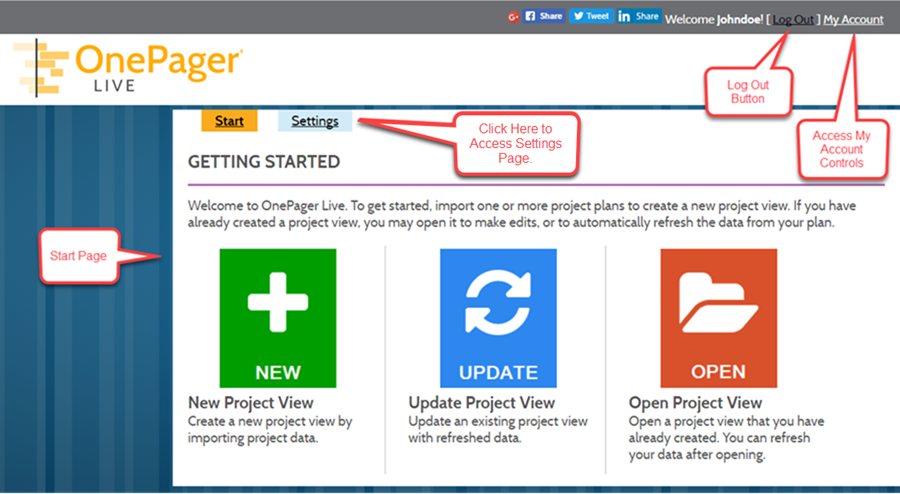
3) Before selecting one of the options on the Getting Started page (i.e., NEW, UPDATE, or OPEN), it is a good idea to unhide the Microsoft Project flag column you intend to use in your Microsoft Project source file. Note that when you unhide a column in Microsoft Project, that column may now appear in some of Microsoft Project’s standard reports. Do not forget to hide the column again before generating such reports if you do not want the column to appear in those reports. The selected flag column allows you to control which tasks get graphed and to store those choices in Microsoft Project for future use. An example of the use of a flag field (e.g., Flag20) is shown below:
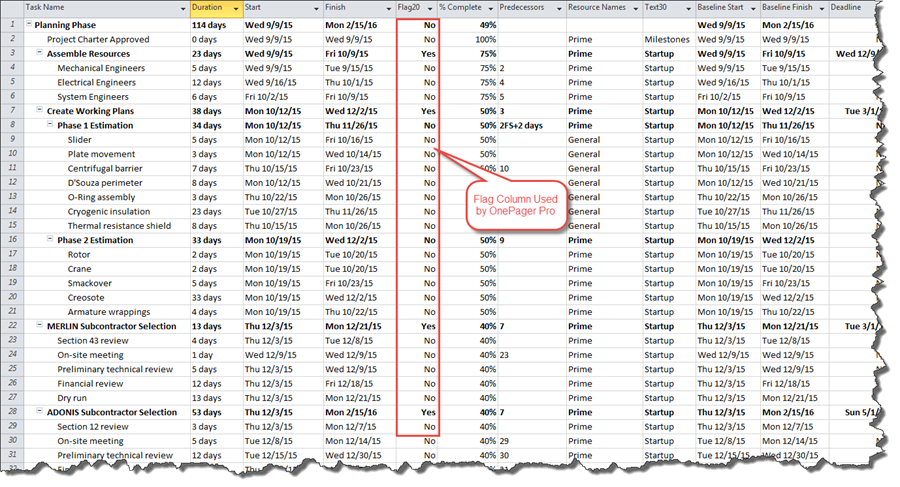
4) To control which tasks get graphed, specify the Microsoft flag column (e.g. Flag1, Flag2 … Flag20) that you wish to use. Number fields may also be used the same as the flag fields where a 1 in a Number field indicates Yes and a 0 in a Number field indicates No. Unhide that column in Microsoft Project by right-clicking in the column header area and selecting Insert Column:
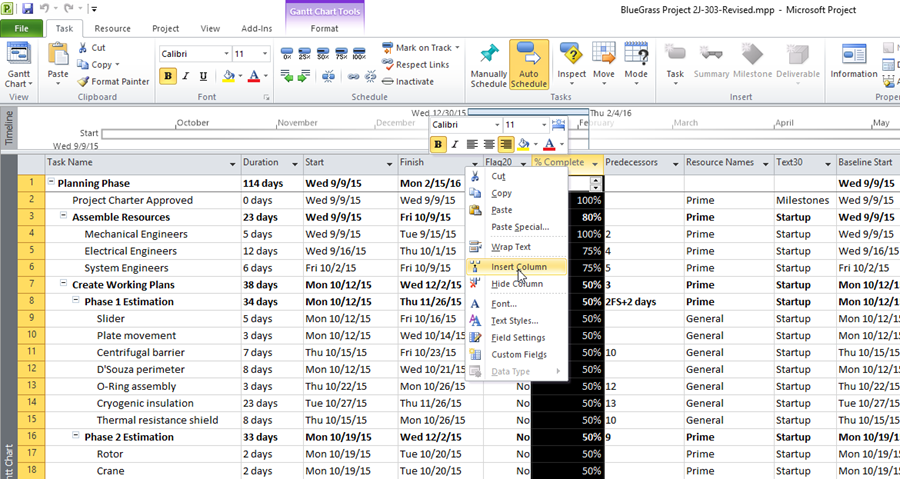
5) Now put a Yes in this flag column for any task that you want to graph:
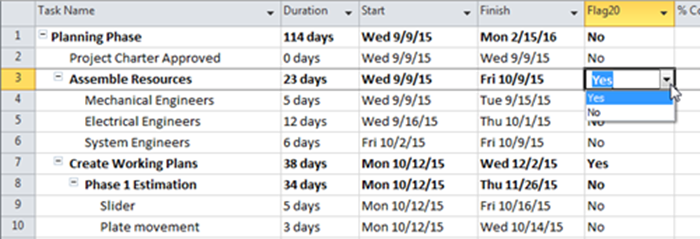
- a) When making your first project view, we strongly recommend that you mark 50 or fewer tasks with Yes as described above.
- b) Please note that OPL has a number of fully populated templates that are based on the Microsoft Project file used in the tutorial also available when you log on – BlueGrass Project 2J-303.
- c) Starting in Microsoft Project 2010, there is a Manual Scheduling mode that allows you to leave dates blank in your schedule. However, behind the scenes, these dates are still being automatically assigned to the project Start Date, or to Today's Date if the project Start Date is not defined. Even though the dates appear to be undefined, they are defined behind the scenes, and are being passed to OPL. Because Today's Date often equals your Snapshot date, it is not surprising to see all of these dateless tasks appearing near the time cursor.
- d) There are two solutions to this issue:
- (1) Define the dates for your tasks and milestones in Microsoft Project. This will overwrite any default dates that Microsoft Project is assigning, and will make your project schedule more consistent with your OPL timeline.
- (2) Remove the dateless tasks from your OPL project view graph. You can leave them in Microsoft Project, but by removing them from the OPL graph, you won't have to explain why certain tasks/milestones are appearing in weird places when they really should not. As a rule of thumb, we recommend defining dates for all tasks and milestones, especially when it comes to graph generation.
6) Clicking any of the icon on the Getting Started page will bring up a sequence of pages that will guide you through the process. The Getting Started page is shown below:

7) The OnePager Live Getting Started page provides you with three options:
- a) NEW Clicking the NEW button will bring up a sequence of pages that will guide you through the process of creating a new project view from a selected Microsoft Project source file or files..
- b) UPDATE Clicking the UPDATE button will bring up a sequence of pages that will guide you through the process of updating an existing project view with data from your Microsoft Project source file or files..
- c) OPEN Clicking the OPEN button will bring up a single OnePager Live page that will assist you in the selection of an existing project view to open and display in the PVE.
Creating a New Project View
NEW Step 1
8) Clicking the NEW button brings up the first page in the NEW project view creation sequence as shown below:
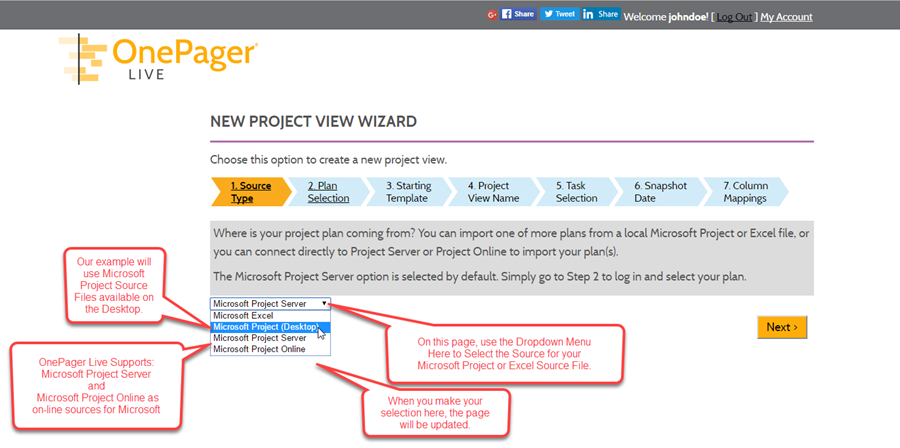
NEW Step 2
- a) As noted in the illustration above, when you make your source file location selection, the page will be updated. As an example, we've selected the Microsoft Project (Desktop) source file location and the corresponding form is shown below:
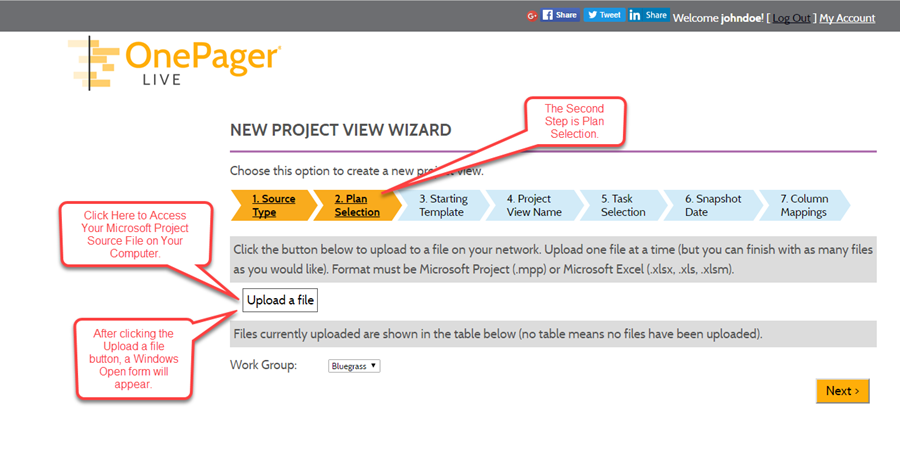
- b) When you click the Upload a file button the Windows Open form will appear. Navigate to where your Microsoft Project source files are stored and select a source file as shown here:
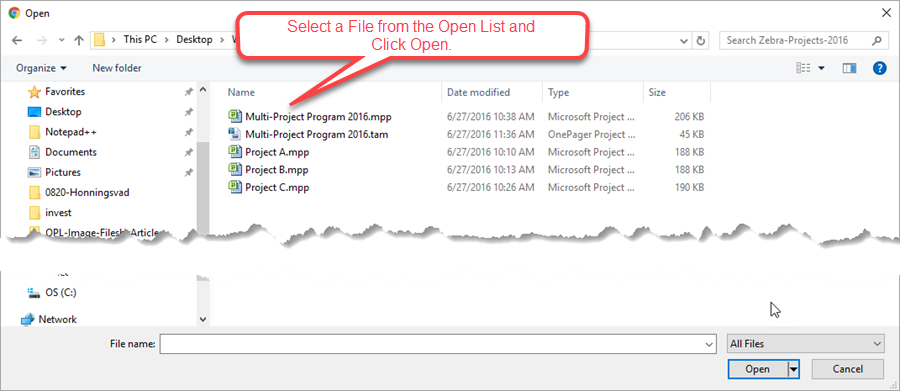
- c) After making your selection and clicking the Open button on the Windows Open form, the OPL page above will be updated to show the selected Microsoft Project source file as shown here:
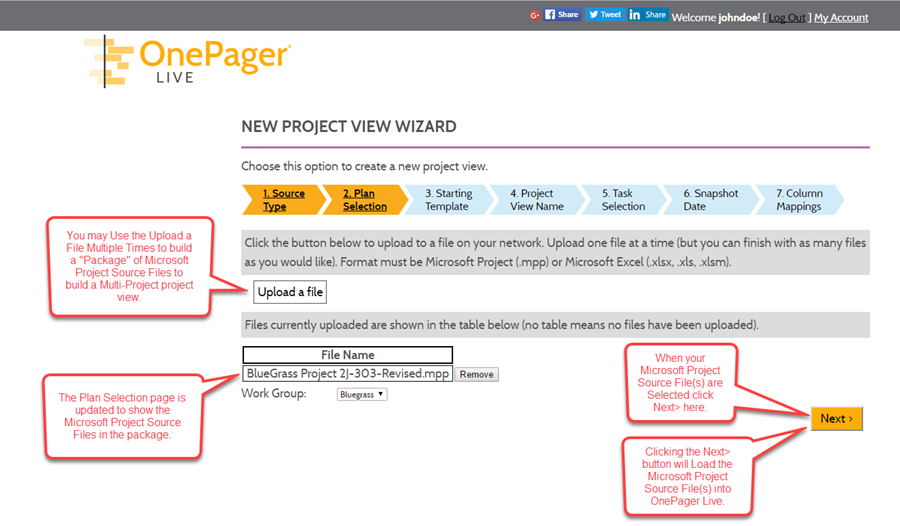
NEW Step 2 - Adding More Microsoft Project Source Files
- i) When you are working in Step 2 you may create multi-project project views by adding additional files using the Upload a file button on this page. Recall that before you create your new project view you can always return to Step 2 by clicking the 2. Plan Selection button. After making a second plan selection the page will look something like this:
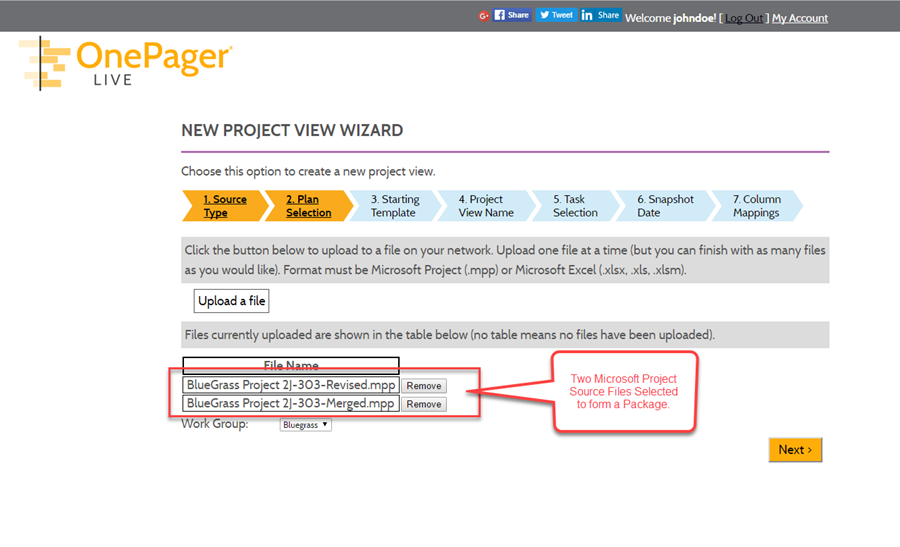
- ii) As a convention within OnePager Live the set of Microsoft Project source files, whether one or more, is called a package.
NEW Step 2 - Removing A Microsoft Project Source Files
- iii) Should you want to reconsider removing a Microsoft Project source file from the package shown above, a Remove button is provided to the right of the names source file.
- iv) Click this Remove button and the Microsoft Project source file will be removed from the package as shown in the two steps here:

- v) The updated Microsoft Project source file package with one file remaining is shown below:

NEW Step 3
- d) Clicking the Next > on the page shown above will take you to the next step in the process - Starting Template. This page is shown below:
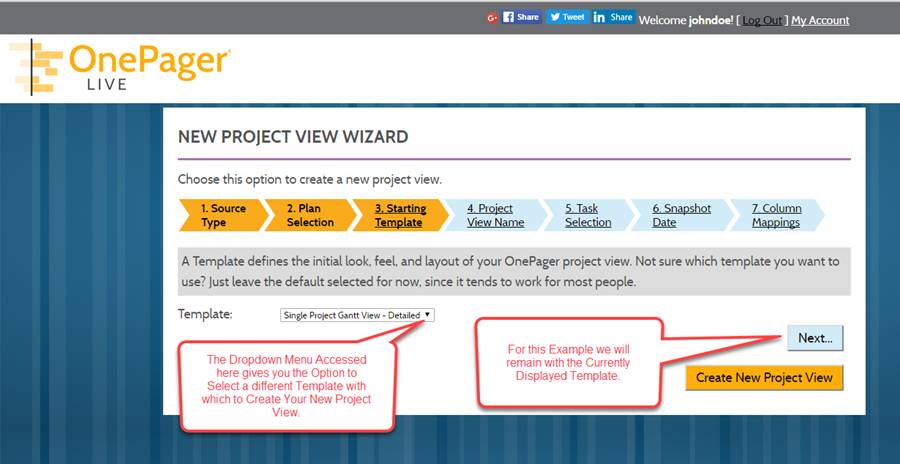
- e) Although we are not changing from the default template in this example, for more information on templates please see these articles: Templates versus Project Views 4.0.1.3-OPL and Managing Templates (Portal) 24.0.1-OPL.
NEW Step 4
- f) After clicking the Next > in the previous step, you will be taken to Step 4 where you may select a name for your new project view as shown below:
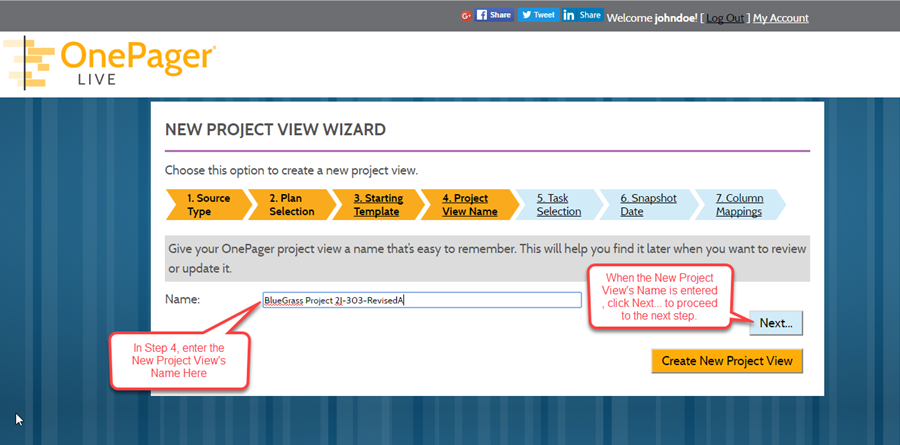
NEW Step 5
- g) Clicking the Next > button in the page shown above will take you to the Task Selection page where you will tell OPL what Flag field to use when uploading tasks/milestones from your selected Microsoft Project source file package. This page is shown below:
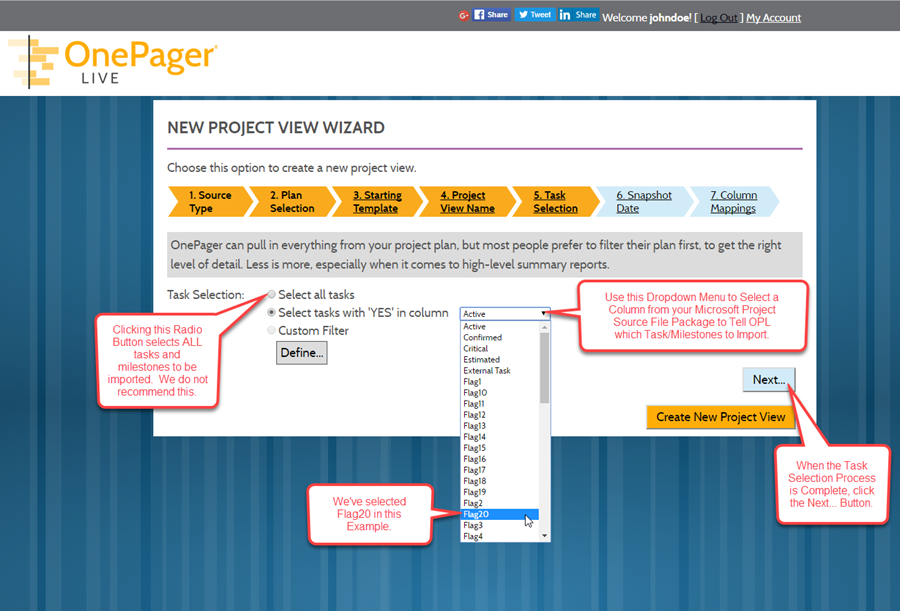
NEW Step 6
- h) After making your flag selection from the dropdown menu, that flag will appear in the window. After you click the Next > button on the page shown above you will be taken to the Snapshot Date selection page shown below:
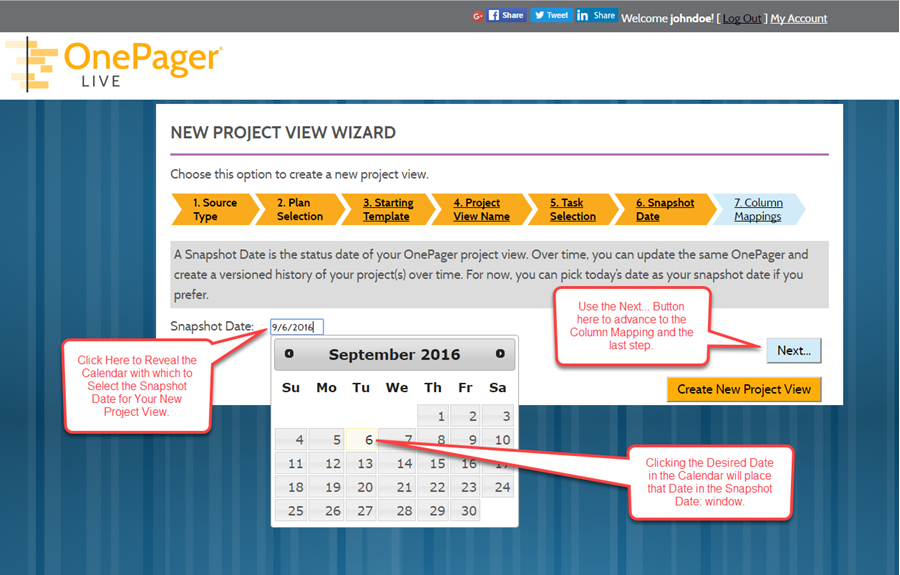
NEW Step 7
- i) The last step, Step 7, is very important because it is your opportunity to make changes to OPL's guesses as how tasks/milestones will be represented and how OPL will be directed to use other Microsoft Project source file columns to create your new project view. Below we illustrate how to update the use of the Resource Names column from Microsoft Project to drive the use of color in the resulting project view:
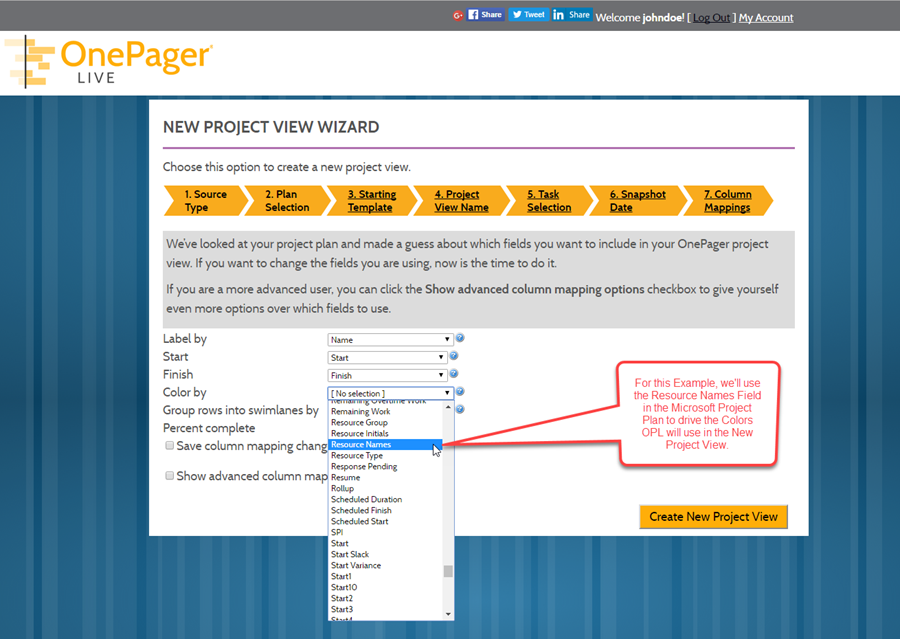
- j) Once this selection is made you may make changes to the other fields on the page that display dropdown menu windows as shown below:
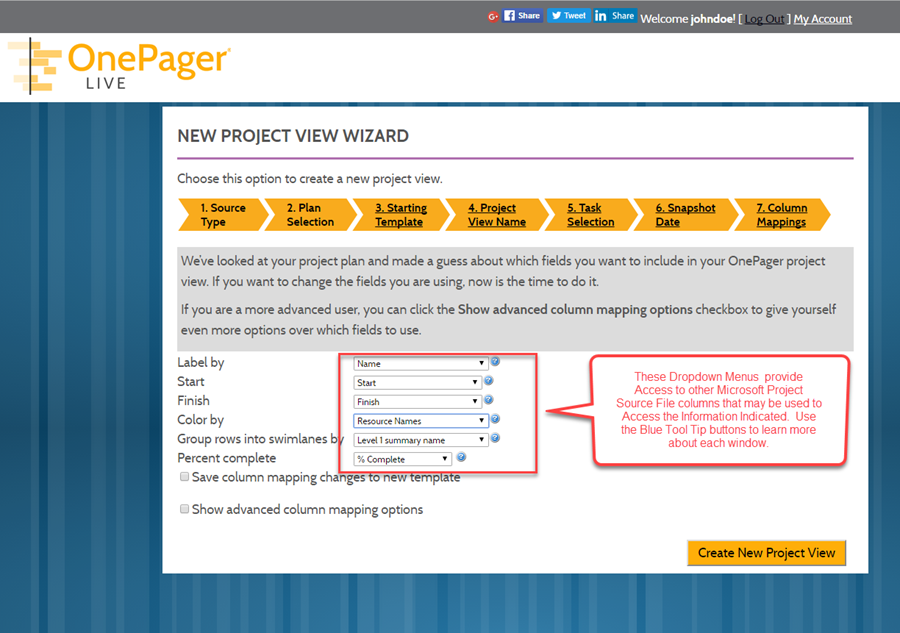
- k) For the time being, just a few brief words about the two checkboxes titled: Save column mapping changes to new template and Show advanced column mapping options.
- i) The Save column mapping changes to new template checkbox allows you to turn the current template with the changes you may have made into a new template with the name of your choosing as shown below:
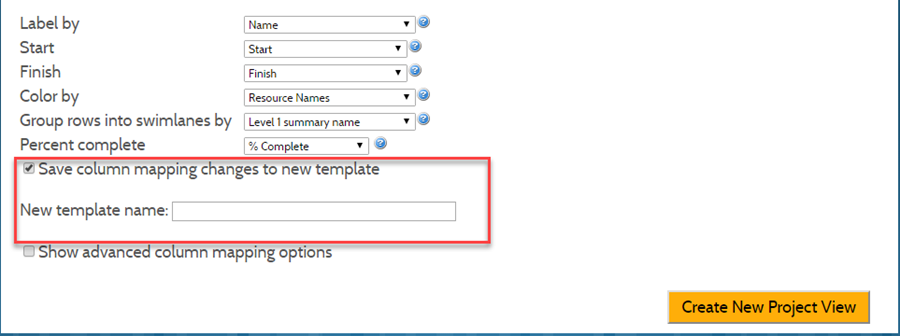
- ii) The Show advanced column mapping options checkbox, when checked, expands to show additional project view labels and corresponding Microsoft Project source file columns for which OPL has made educated guesses on how you might use them. Please consult this article for more information: Template Only Features 24.1.1-OPL. The expansion of the page is shown below:
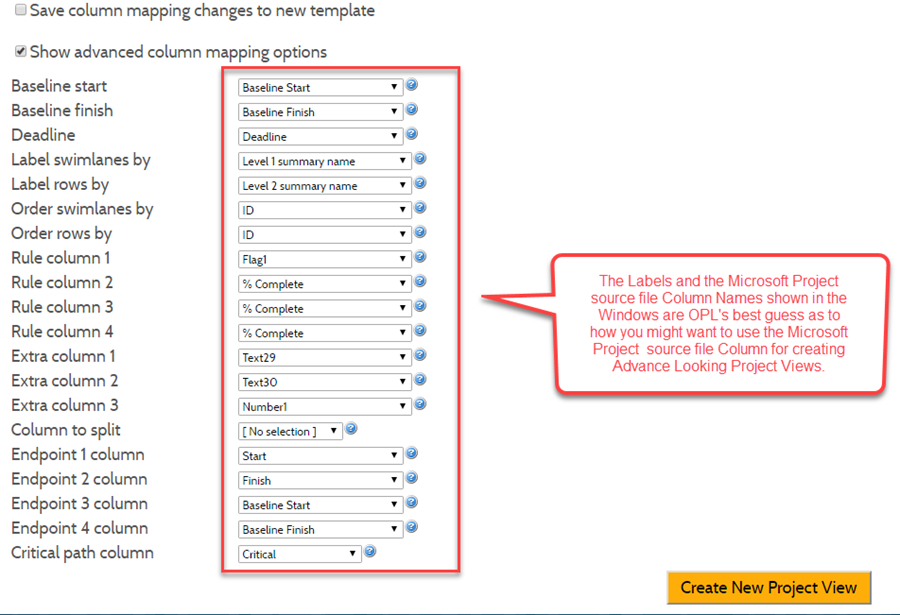
9) As a note, you may, at anytime you are beyond Step 2, go back to a previous step by clicking on the desired step arrow icon near the top of each step page:
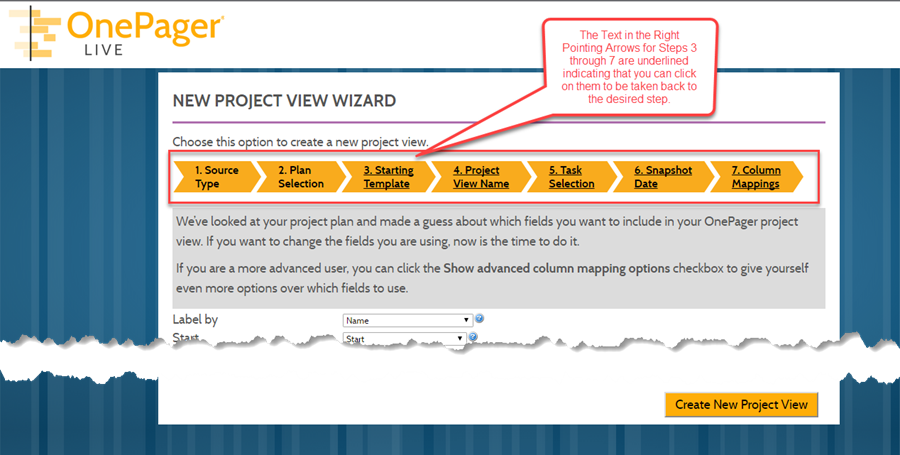
Making the NEW Project View
10) After completing all or needed preliminary steps as described in the previous sections, click the Create Project View button at the bottom of your last page to tell OPL to make the new project view and display it in the PVE as shown below:
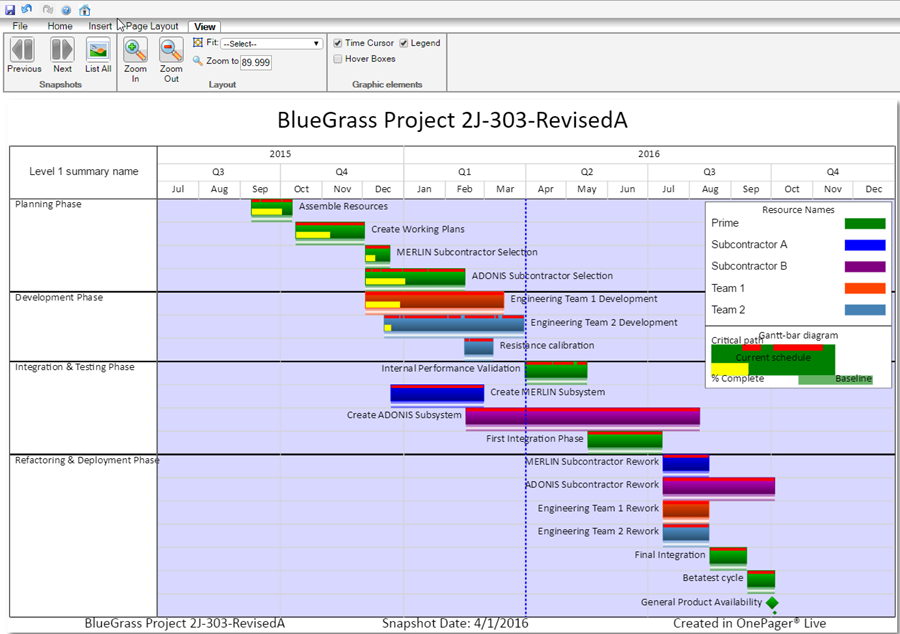
11) Note that each task or milestone was color coded based on the value in the Resource Names column.
- a) The legend contains an optional diagram near the bottom explaining that the bars inside the Gantt bars represent percent complete extracted from Microsoft Project.
- b) Percent complete and Color selection come from a Microsoft Project columns that you specified on the 7. Column Mapping page shown above.
- c) The current template, when you press the Create New Project View button, is the template you specified on the 3. Starting Template page also shown above.
Opening a Project View
12) The right-most button on the Home (Getting Started) page is the OPEN button. Clicking the OPEN button displays a dropdown menu which happens to be the same for the NEW and UPDATE buttons. The options in the dropdown are discussed below:
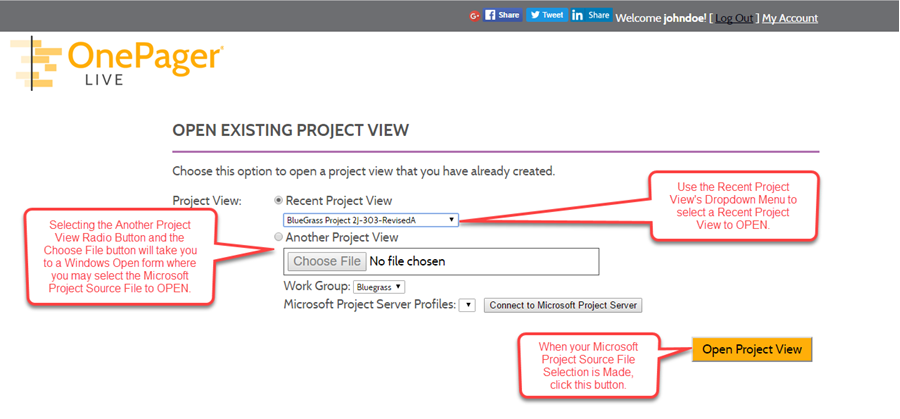
- a) Clicking the Recent Project Views button activates the dropdown menu where you may select from the list of project views (.TAM files) recently created and/or updated. Selecting from the list in the dropdown menu will update the project view name shown in the window.
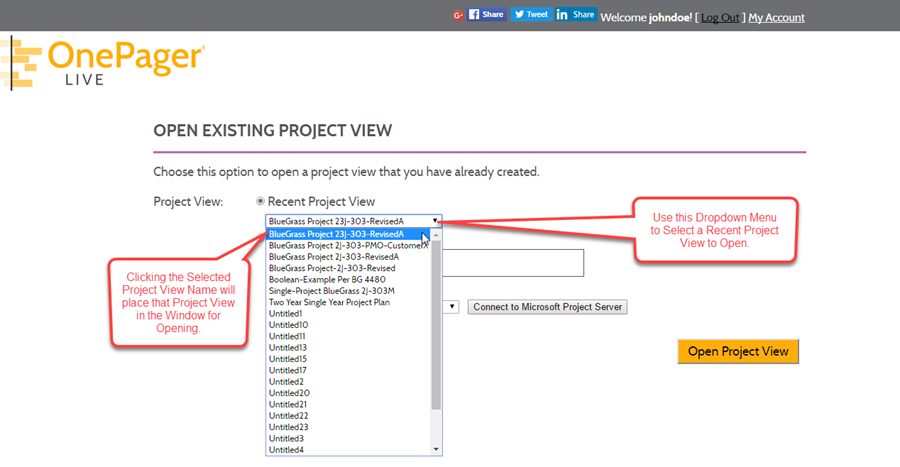
- b) Clicking the Another Project View radio button will activate the Choose File button. Clicking the Choose File button bring up a Windows Open form from which you can select a .TAM file that you want to open. Selecting the desired .TAM file will cause OPL to display the selected project view in the PVE when the Open Project View button at the bottom right is clicked as shown above. From this position, you may edit the project view, save it, or share it with others.
Updating a Project View by Adding A Snapshot with Changes Made to the Microsoft Project Source File Data
13) Suppose after examining the project view you created before, you realize that it would be best to show more task bars. This, you think, would greatly improve the schedule discussion you are about to attend. Updating the project view at this point is a simple matter. Recall that OPL is active and the PVE is displaying the current project view you want to update. Additionally, the Microsoft Project source file and the application are active. The original project view looked like this:
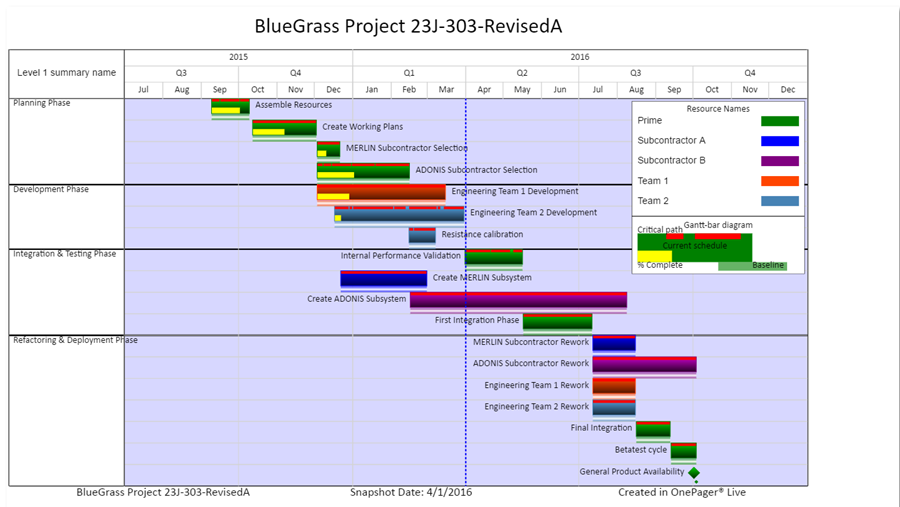
- a) Since Microsoft Project is still an active program and the Microsoft Project source file you are using is still being displayed, go back to the Microsoft Project application and change the Flag20 column setting for the rows you want to now display from No to Yes. A section of the Microsoft Project source file where this is done is shown below:

- b) Once you’ve made the Flag20 changes lines 8 through 15 in the Microsoft Project the source file will look like this:

- c) With the Microsoft Project source file updated, go back to OPL's home page. Now click the UPDATE button on the home page as shown below:
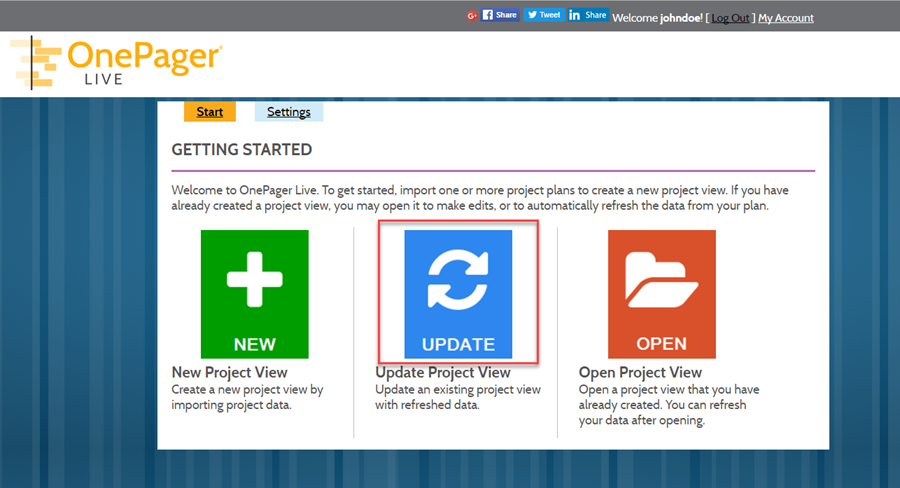
Update Step 1
- d) Clicking the UPDATE button will take you to the first step in the Update process as shown below:
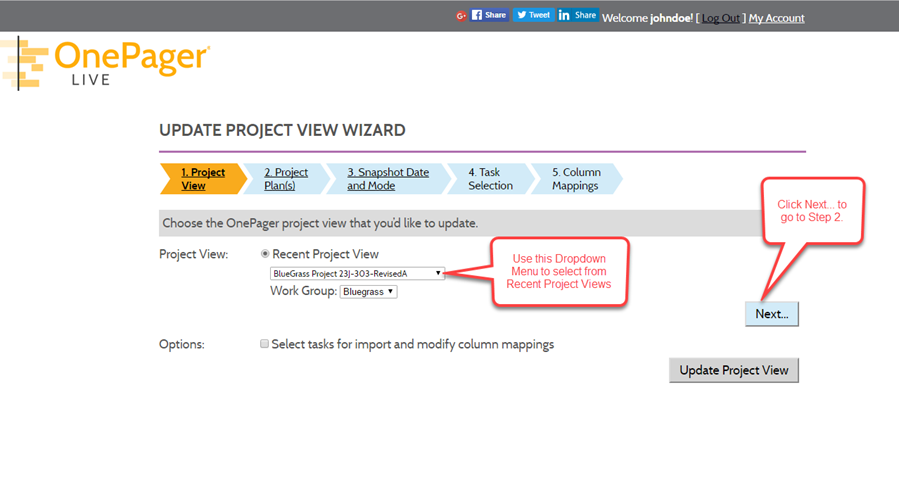
- i) Use the Recent Project View dropdown menu to select the project view you want to update.
- ii) You have the Option at this point to manually select the tasks to be imported and to make changes to the column mapping. ***TBD***.
Update Step 2
- e) After selecting the project view to be Updated, click the Next... button to go to Step 2 as shown below:
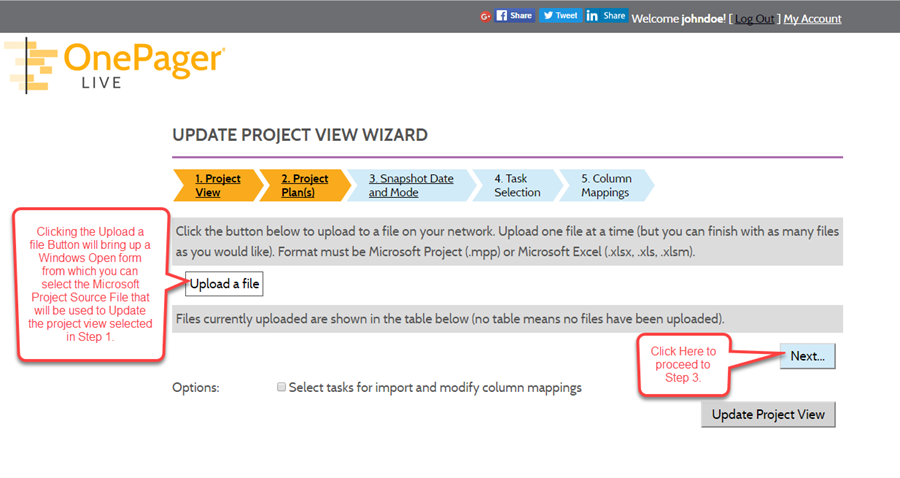
- f) After selecting the Microsoft Project Source File from which you will update the selected project view, the OPL page will look like this:
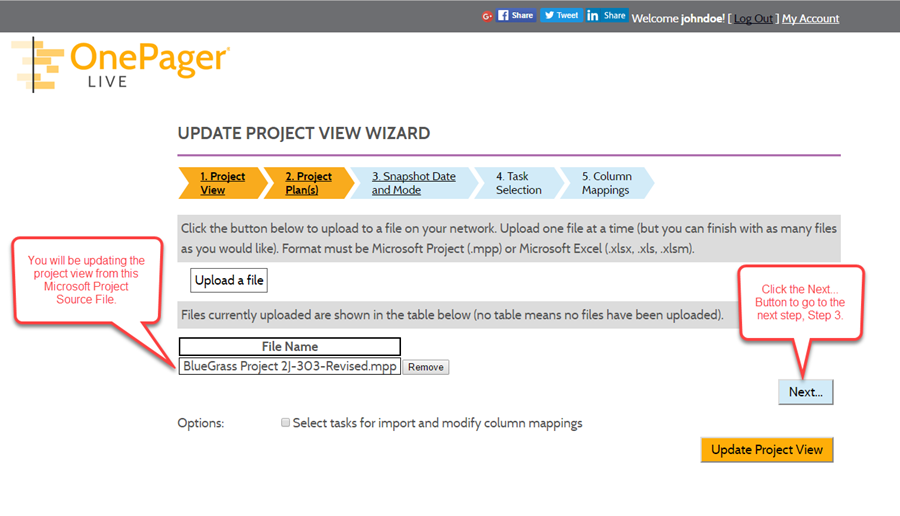
Update Step 3
- g) After completing Step 2 and clicking the Next... button, you'll have several options in Step 3 to select the snapshot mode and date as shown below:
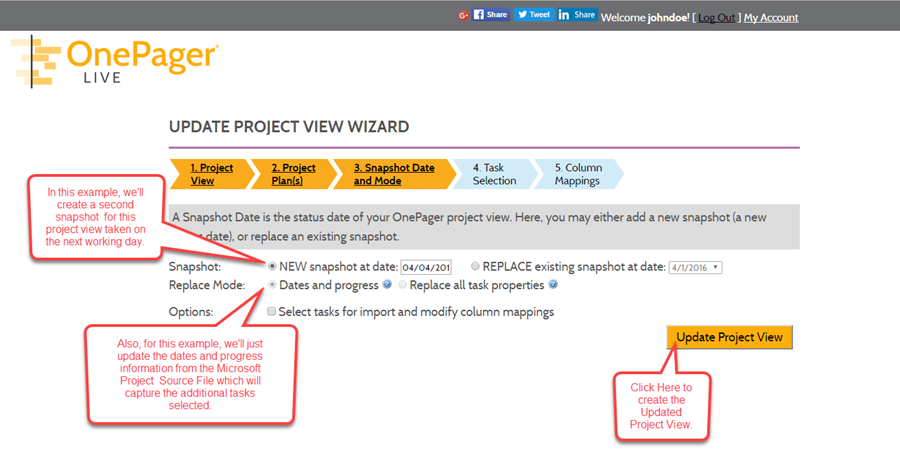
- h) Since we did not exercise the option, available from Step 1 through Step 3 to make task selection or column mapping changes, we can go directly to creating the Updated project view by clicking the Update Project View button.
- i) At the conclusion of the operation, the updated project view will look like this:
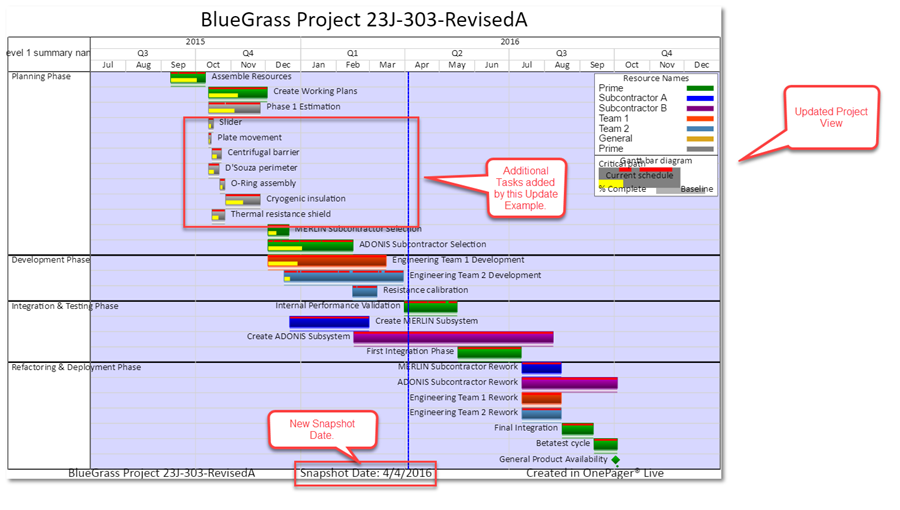
14) The example above is just one of many approaches to Updating a project view. In addition to adding and removing rows by changing the Flag20 field, you may need to change Start Dates, Finish Dates, or Percent Complete and display these data changes in the project view. Using the procedure above you can do this very efficiently.
15) As shown in Step 3 you may also Replace an existing snapshot already associated with the project view by its snapshot date. Other examples are shown in the series of articles at Basic Workflows (Portal) 7.0.1-OPL.
16) At this point you may save the project view by giving using the Save icon on the OPL tool bar. When you save the project view in OPL, OnePager will save the .TAM file and within will save the Microsoft Project Source File name and path information. This is useful when you want to further update the project view or when you want to add a snapshot later on.
Editing the Project View
21) Sooner or later, most of you will edit the font sizes and text position to optimize readability. For example, suppose we want to change the size of the task labels for a series of tasks and milestones in the lower right of the project view as shown below:
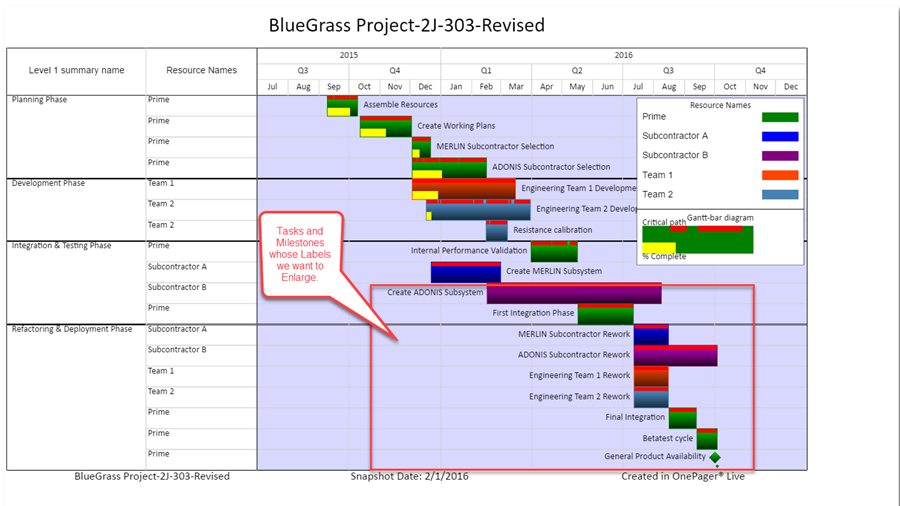
- a) To select the tasks, hold down the Left Mouse Button and sweep the mouse over the tasks/milestones you want to select. When you are finished, the selected tasks will look like this:
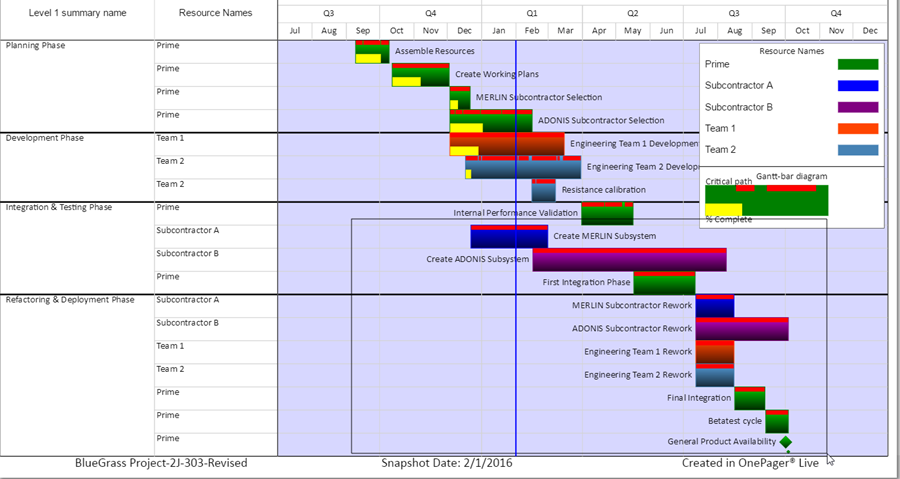
- b) When you release the Left Mouse Button the selected tasks and milestones will look like this:

- c) Click the Increase Font Size button on the tool bar shown below:

- d) The project view will now look something like this:
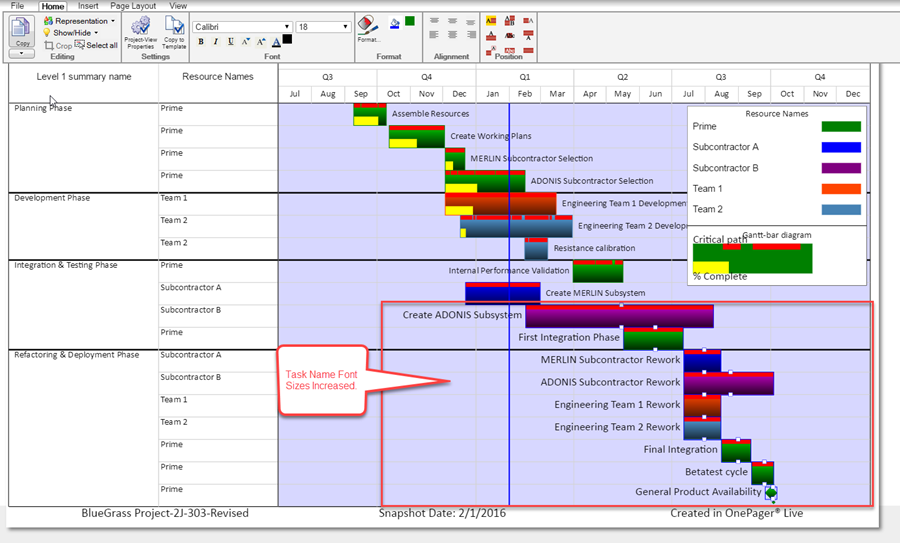
- e) Repeating this operation for the remaining tasks/milestones (we could have done Select Alland done it all at once!), we obtain a project view with larger fonts on all the tasks/milestones:
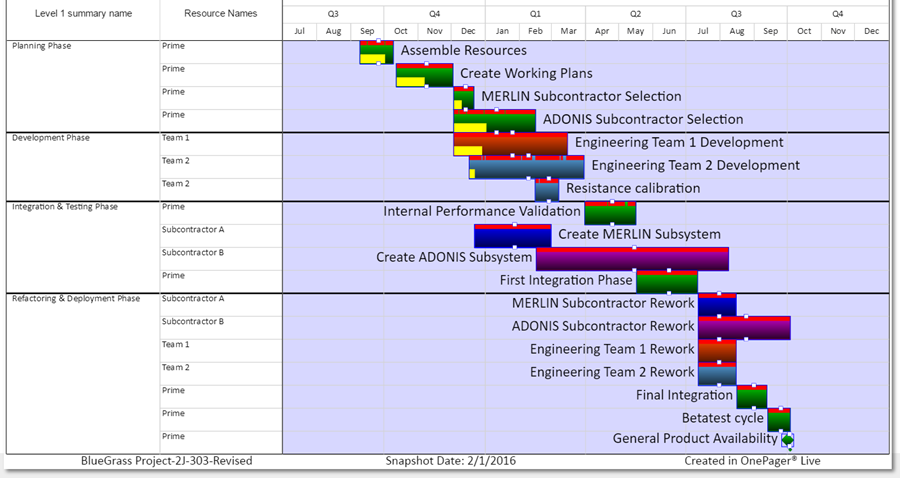
22) Another common editing action is to move the task names from their current position, centered on the task, to a position left or right of the task. To do this, select a set of tasks/milestones as before, but this time click one of the text-positioning buttons on the tool bar:

- a) Doing this on several batches of tasks/milestones results in the following edited project view. (We have also dragged the legend to a new position and have adjusted some of its font sizes):
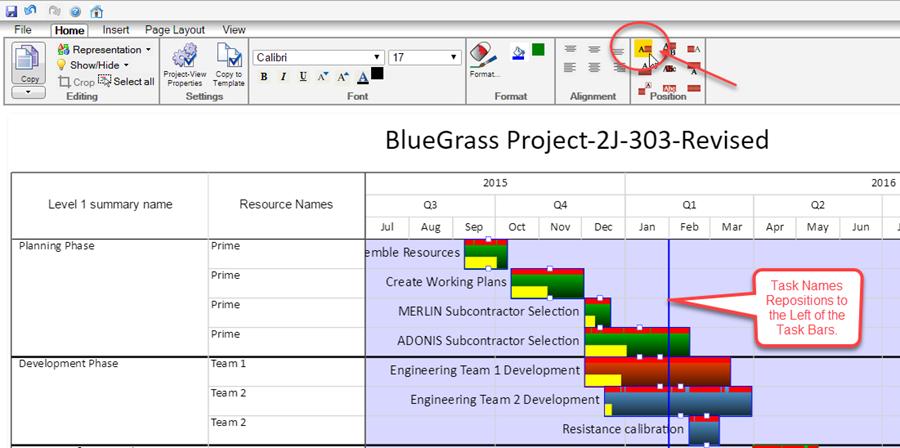
- b) In case you change your mind about the last editing action you took, you can undo the last editing action by clicking the UNDO button above the OnePager Live tool bar. Successive clicking the UNDO button will undo editing actions in the reverse order that they were applied.

23) Save the edited project view by pressing the Save button above the tool bar next to the UNDO button. All of the font-size changes, text-position edits, and the new legend position are now saved in the file structure in case you need to update this project view with new data at a later time.
Copying the Project View to PowerPoint
24) Finally, you may want to copy the current snapshot of the project view into a Microsoft PowerPoint presentation. To do this first, click the Copy Button on the OPL Home Tab. This action will bring up a Windows Save As form so that you can select the location of the generated *.pptx file and its ultimate name. The Windows Save As form is shown below:
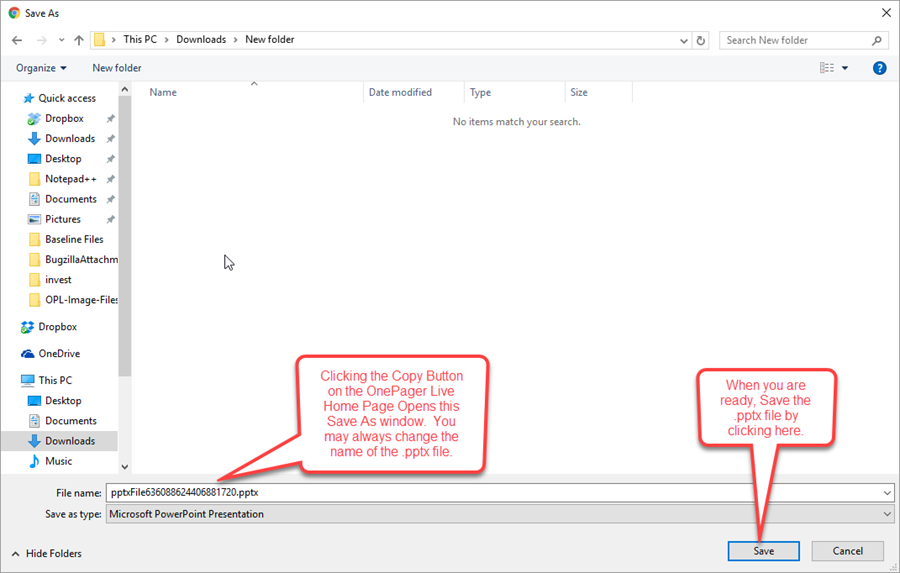
25) Access your generated *.pptx file which will bring up Microsoft PowerPoint as shown below with the copied project view.
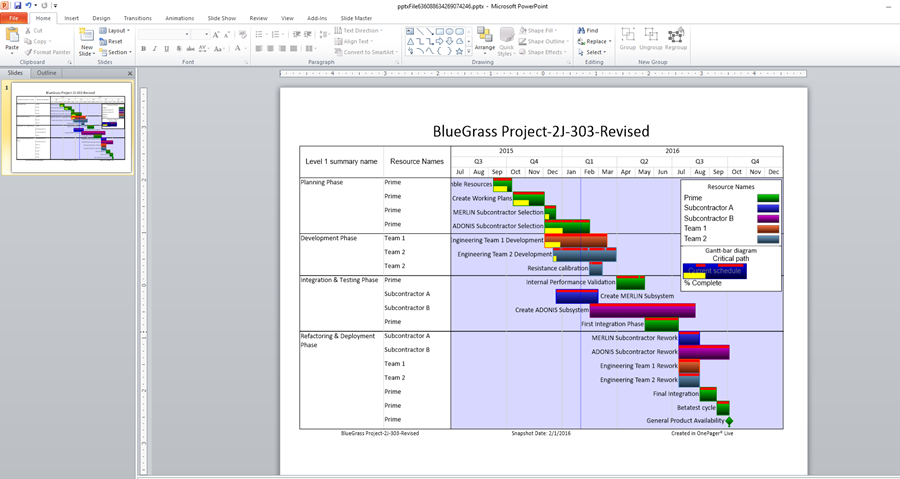
25) TThat’s it! You’ve now created a professional 1-page schedule summary from a complex Microsoft Project schedule and have copied it into a Microsoft PowerPoint presentation. You can also print the graph by selecting the Print button on the File tab. OnePager Live has other features that let you move tasks vertically to different rows and swimlanes, change the number of swimlanes, add swimlane titles, show dependencies among tasks, change task colors, hide tasks, add floating comment boxes, and standardize on graph styles across organizations. To learn more about these features, read about the specific workflows in this Wiki at Basic Workflows (Portal) 7.0.1-OPL.
(3.0.1.1-OPL)